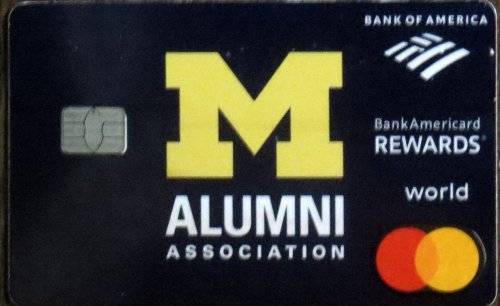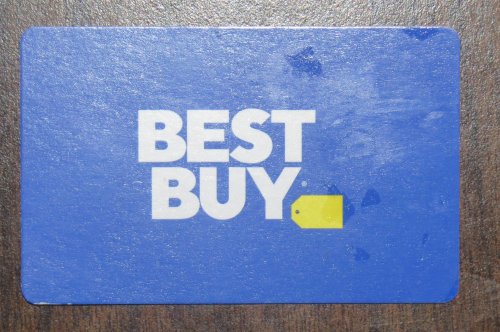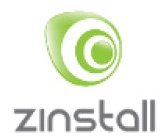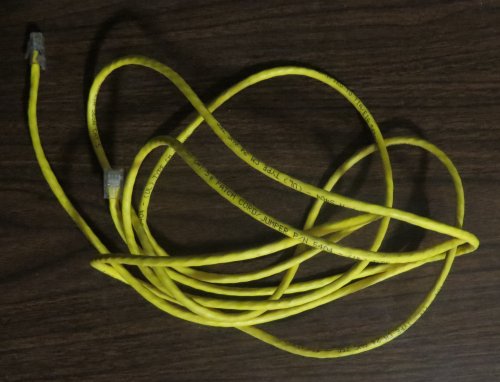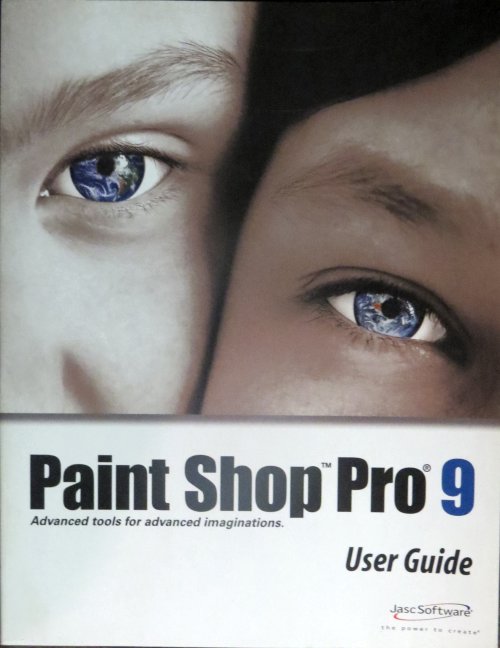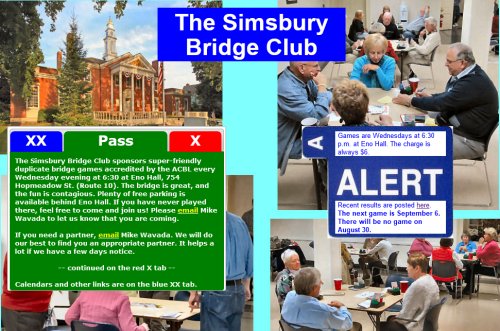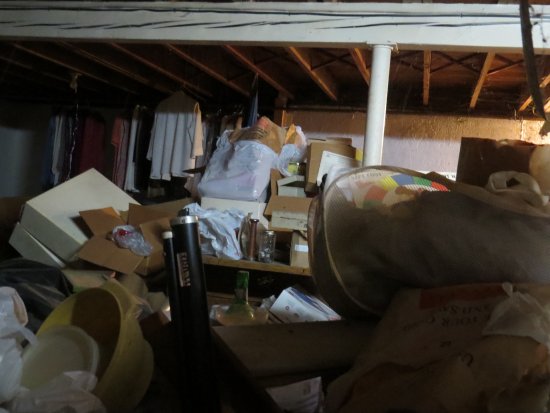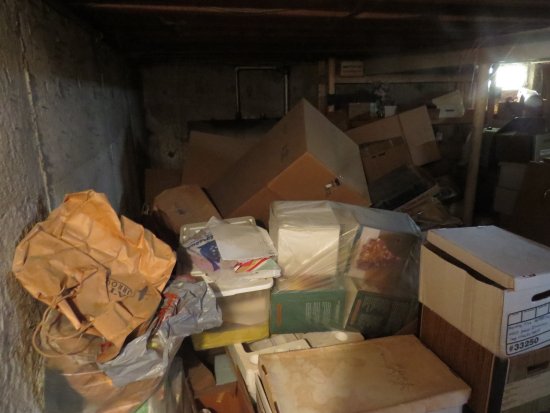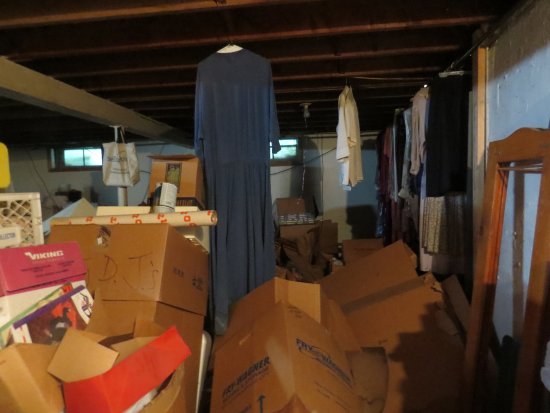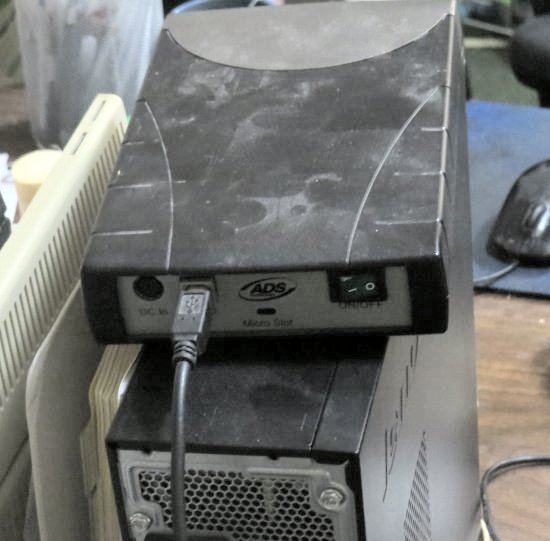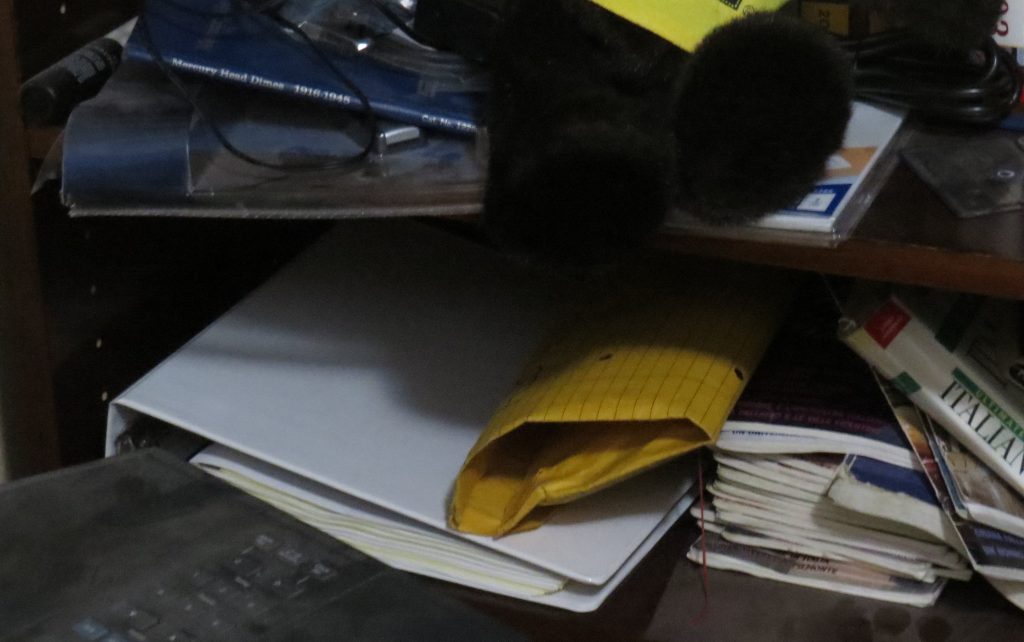It’s name is Asus. Continue reading
By the beginning of September of 2023 I had become quite frustrated about the time that I had been wasting because my Lenovo desktop computer, on which I had keyed in the great bulk of the entries in the 1948 Project (introduced here), was intolerably slow. The biggest problem was that the system would quite often lock up for as long as ten or fifteen minutes. During these periods the disk light was on continuously. I had tried to determine the cause by examining the output available in Windows’ Task Manager, but I had no luck. I had also asked the Greek Squad to look into it. The agent signed on to my system, deleted a lot of temporary files. That seemed to help for a day or two. However, it reverted to its previous behavior shortly thereafter.
Another problem was its connection with the Cox modem/router. The connection would be lost for no apparent reason, and it was often difficult to recover. A few years earlier I attached a modem that I had previously purchased to a USB port. That did not seem to help much
So, in desperation I decided to purchase a new box. I did some research on the Internet. The new systems seemed to have much faster processors than my Lenovo desktop. The hard drives were in most cases a little smaller, but that did not concern me much. The amount used on the Lenovo was far less than the capacity of any of the available machines.
I had had pretty good experiences during my last two computer difficulties (outlined here) with the Geek Squad people at the Best Buy store in Manchester, CT, which was about a thirty-minute drive from my house. I therefore decided to buy one there.
I cashed in the points on my Bank of America Mastercard for a Best Buy gift card in excess of $300. The units at Best Buy started at about $600 unless I was willing to settle for an obsolete model that ran Windows 10 or an “open box.” I decided to put a new system on order shortly after I received the gift card in the mail.
Unless I did not mind making several trips to the store, I figured that the easiest way was to order it online and pick it up at the store. Before I did so I had an electronic chat with one of Best Buys sales agents. I told him which model (an Asus) I was interested in, but I also expressed my concern about the difficulty of migrating the programs that I used. I specifically emphasized that the one that I was most worried about was Outlook, Microsoft’s email product. The agent assured me that the Geek Squad people at the store could help me with that. That convinced me to put the system on order. It was scheduled to be at the store on Friday, September 21. I actually received an email that it had arrived a day early. I had a big project to work on over the next few days, and so I planned on picking it up on Monday.
I had a long and strange electronic chat with agents from Best Buy on Friday. When I explained my concern about Outlook I was transferred to a different agent who allegedly specialized in this. A little later I was transferred again. This agent assured me that the Geek Squad would do the entire migration for me and made an appointment for me for 3:20 in the afternoon on Monday.
I left for Best Buy at 2:30 on Monday and arrived at 3. I had no trouble obtaining the new computer. I had brought with me a bag that contained the Lenovo that I had been using as well as a very old external hard drive for which I had lost the power cord. I intended to ask the Geek Squad people after they had migrated the programs and data if there was any way extract the files that were on the external drive onto something usable.
The Geek Squad guy was very friendly, but he said that they only did data, not programs. This was very upsetting to me. The only reason that I had purchased the machine from Best Buy was for the help that I expected to receive. Migrating the data was no challenge if you had a large external hard drive, and I did. I was so upset about the lies (or maybe misunderstandings) that I left Best Buy without remembering to ask about the hard drive. As I drove out of the parking lot I was so concerned about what should be my next step in making the system in my trunk operational that I almost ran a red light and caused a serious accident. The rest of the drive home was uneventful.
Plan Z: In my research I had come across a company name Zinstall (website here) that markets a downloadable program called WinWin that the website claimed was able to transfer all of one’s programs and files from any Windows computer to a new Windows 11 computer. It cost $129 plus tax.
On the evening of Wednesday September 272 I started an electronic chat with someone named Paul from Zinstall. He assured me that they installed software, called WinWin, that could transfer all the programs, but it was possible that Microsoft would demand proof of ownership in the form of a serial number or program key. A little more research convinced me that this was quite unlikely. Besides, I could not see an alternative. So, I purchased the software. I received the following email:
Thank you for choosing Zinstall.
A. DOWNLOAD LINKS
1. CLICK THE FOLLOWING LINK to download the SOFTWARE: (link)
2. You should download and run the software on BOTH computers: OLD and NEW.
3. IMPORTANT: before taking any further steps, you should carefully read the USER GUIDE. CLICK THE FOLLOWING LINK to download the user guide: (link)B. ACTIVATION INFORMATION: Below is your Zinstall license activation key serial number. You will need to supply this information when prompted by the software.
Serial number: WNPV-XXRR-BJDK-VJK6-USOP-I2XP-LGXO-6UEV-74
Registered email: Mike@Wavada.orgC. SUPPORT AND SERVICE We are glad to assist you with your transfer.
1. SUPPORT QUESTIONS & TROUBLESHOOTING: For any support questions or assistance, CLICK THE FOLLOWING LINK: (link) where you will find answers and solutions for your questions, as well as options to contact the Support Team.
2. If you require TECHNICAL ASSISTANCE, please submit the “Support Case Form” and run the Diagnostic Tool on both computers (old and new). Both the Form and the Diagnostic tool are available at the link above.D. FULL SERVICE – REMOTE ASSISTANCE: IF you prefer the convenience of having an expert tech perform the whole transfer for you, you have the option of a Full Remote Service add-on. It is available here at a discounted “bundle” price: (link).
E. BEST PRACTICES: HOW TO PERFORM A MIGRATION? Before starting the migration process:
1. Make sure you have a backup of your computers.
2. Save all open files and close all running applications.
3. Completely uninstall all Internet Security Suites, Firewalls, and Antivirus on both computers – OLD and NEW.
4. You don’t need to purchase any special cables or external hardware to do the transfer. If your computers are connected to a home network, you don’t need to do anything – Zinstall will use the network for the transfer. Otherwise, you can just use a regular network (aka Ethernet) cable – you probably already have one – to connect the computers directly. Here is what it looks like: (link).
5. While wireless is usable as well, if you have an option to use Ethernet – use it. Wireless is inherently slower, and may be interrupted by network disconnects.
6. The migration process requires “Administrator” user privileges.IMPORTANT: The transfer may continue for a very long time – DO NOT INTERRUPT the process, even if it seems that nothing is happening for a while. REMEMBER: Once started, the migration process is completed unattended – you are not required to stay near the computers, and may leave it for the night to complete.
One thing that had not previously been clear was that I needed to connect the two computers via an Ethernet cable if they were not already on a network. I thought that it would be sufficient that both used wi-fi. I had been planning on sending the data through the modem/router from Cox Cable.
I asked Sue if she knew if we had an Ethernet cable. She said that she had at one time put all of the miscellaneous cables in a big plastic tub. I naturally asked where it was. She said that she didn’t remember. I was not surprised. I made a mental note to drive to Target on Thursday morning to purchase one. Target’s website offered a seven-foot cable for $10, and they seemed to be in stock..
In one of my dreams that night, however, I had a revelation that there might be one in the north end of our basement near the AS/400 that I brought home in the summer of 2014 after we closed TSI’s office in East Windsor.
When I awakened in the morning I hastened downstairs and discovered that there were indeed two Ethernet cables in a snake’s nest of cables near the computer. I wrested one away and without too much difficulty I was able to connect the two black boxes on my desk. When the yellow lights appeared in the sockets for both, I rejoiced. I had saved $10!
The migration: The instructions sited above were thorough and instructive. As someone who wrote such instructions for users of his code for thirty-five years, I have one quibble. Users expect the written instructions to be in the order in which they are to be executed. In this document some of the most important pieces of information are near the end. I admit that I never read sections B, D, and E until I started writing this account on Friday.
I downloaded the WinWin software to my old system, Lenovo. I found the executable file in the Download folder and ran it. According to the instructions I should have run it as administrator, but I didn’t. The program churned for a few minutes and then asked me whether this was the old computer or the new one. After I selected “old” it told me to do the same thing on my new computer Asus.
I had planned to use the same display on both computers.3 So, at this point I needed to detach it from Lenovo and insert it into Asus. This turned out to be a much bigger pain than I thought that it would be. In the first place the lighting in that area of the office was not good.4 The head of the cable was held in place by two screws. No screw driver was needed, but it took longer than I remembered to screw and unscrew them with my fingers.
After I attached the display I turned on Asus for the first time. It came up rather quickly. Among other things it asked for a PIN. I used the same one that Sue and I use for the garage door opener. It invited me to take a tour of Windows 11, but I postponed that adventure until some undisclosed point in the future.
Instead I selected the Edge icon on the desktop, downloaded the WinWin executable again, found it in the Download folder, and ran it. The same window came up, and, when asked, I said that this was the new computer. The program then searched for the old computer. This was the moment of truth, or I should probably call it the first moment of truth.
It was not to be. The screen displayed a sad message (#324) that indicated that it could not find the old computer. The likely cause, it said, was either that the two boxes were not connected or that security software on one of the boxes was preventing the connection.
I checked the back of both computers. The Ethernet cables seemed to be securely attached. I then uncabled the display from Asus and reattached it to Lenovo. By coincidence almost as soon as I could see the display again a window appeared for the Webroot program that the Geek Squad had installed. It had options to end three types of security. I did so. Consequences be damned.
I then sent to the support team at Zinstall an email explaining the situation and identifying the error message number. I received two identical “high importance”messages one minute apart: “Hello Michael Wavada, This is an acknowledgment we have received your email. We will contact you soon. Best regards, Zinstall support team”
I would have preferred something more specific than the word “soon”, even if it was “within the next 24 hours”. I felt that Zinstall recognized the urgency of the problem, and I could expect an email with specific instructions within the next five minutes, or five hours, or maybe five days. I stayed at Lenovo’s keyboard4 and won game after game of two-suited Spider Solitaire while intermittently checking the Inbox in Outlook. At about noon I fixed myself a ham sandwich and ate it in front of my desk while I kept my eye on the Inbox.
I almost always took a nap after lunch. Mine on that day was a rather short one, and I rushed back to check the Inbox as soon as I was awake. No dice.
At 1:47PM I sent a short missive to Zinstall support: “How long is soon? It has now been over four hours.” Nearly an hour later I was about to send another email when this showed up in the Inbox. It was signed by Sam R.
Thank you for contacting us.
You have Webroot still active on the old computer.
Please disable Webroot firewall on the old computer (or simply remove Webroot from the old computer), and run Zinstall again on both.
Please let us know how we can assist further!
I replied as soon as I could: “I believe that I disabled it before running Zinstall. I tried to delete the folder named Webroot, and it said that I need permission from SYSTEM to do so. I do not know how to do that. Actually I seem to have two copies of Webroot. One in Program Files, and one in Program Files x(86). The Geek Squad installed them.”
Sam R. must have been horrified about what I had attempted. He wrote back rather quickly.:
You should not delete folders directly; instead, you can typically right click on the Webroot icon in system tray (bottom right corner, near the clock) and select “Shut down” or “Exit”.
Or, to uninstall it, go to the list of installed programs and select Webroot there.
Alternatively, if you cannot get rid of Webroot, another alternative is to use Zinstall with a USB external drive instead of network.
Do you happen to have a USB hard drive available?
I did have an external drive with a great deal of storage, and it was within two feet of my right hand. Nowhere in the emails or the online instructions booklet was there any mention of this option. Maybe that could be plan Z2 if we could not get past the security issue. In the process of disabling Webroot in the way that he described I noticed that the system clock was off by more than two hours. While I was in the same system tray I also found a Malware icon. There was no option to disable it. I select “Quit” instead. Both icons disappeared from the tray.
Uncertain whether Sam R. would still be working, at 5:04PM I sent the following message to describe what I had done since receiving his (her? their?) last email:
I tried this twice. On the first try I received the same message as before even though Webroot was not listed in the Apps. The second time I removed Webroot again (the system had rebooted on its own) and Malware Bytes from the Apps in the lower right corner. This time the program on the new box found the old box, but it warned that I was using a wireless connection that might be slow or fail. The lights for the Ethernet ports are on on both machines. Is there a way to verify the connection? I do not have a network (other than the Cox Cable modem/router). I just ran a cable between the machines.
Later I became convinced that Lenovo had not, in fact, rebooted on its own. I was pretty sure that the AC cable had been jostled loose while I was moving the display cable back and forth between the two boxes.
I decided to try it again, and I was cautiously optimistic. However, the email sent at 6PM told a different story: “It is now showing message #11. This is SO FRUSTRATING!” Message #11 said that my account had reached the limit on the number of tries. I did not receive an answer on Thursday.
I was poor company all evening. I was close to giving up on Zinstall, but I had no alternative at this point. I began to consider contacting American Express to tell them not to pay for the service. I went to bed at about 9PM, which was quite early for me.
On Friday morning I was pleasantly surprised to receive an email from Sam R. The time stamp was 4:14AM.
Thank you for the update, it’s great that the connection issue is solved now that Webroot is removed!
Regarding wireless, you do not have a huge amount of data on the old computer, so you can transfer via wireless as well.
As long as the wireless network is not abnormally slow, it will complete just as well.
Note also that you can use the old computer while the transfer is in progress, if needed – just press the Windows key on your keyboard to get to your apps / desktop.
Please let us know how we can assist further!
I asked him about error #11. He said that that had been cleared. I did not respond to his comment about being able to use the old computer. Once the process started, I intended to monitor it on the new computer. I had no intention of touching any of the cables once the migration was under way. He probably did not remember that I was switching the display from one machine to the other.
Before I ran the WinWin program on Lenovo I made certain that neither security program was in the system tray. When I moved the display’s cable, I was very careful not to jostle the AC cable on Lenovo. I then checked to see that both Ethernet lights were on.
At about 8:20 (I know because I always awaken Sue at 8:30) I initiated the WinWin program on Asus. This time it found Lenovo, and it did not present the warning message about using a wireless connection. It must have been using the Ethernet cable.
The process took about three hours. I used part of the time to go through the papers that had been accumulating on my desk for a few months. That was a worthwhile activity. I found a year-old credit from Costco for $1.48 and the paperwork for applying for a discount on the real estate tax levied by Enfield. I also found my hanging file for income tax for 2019. I had no idea why it was out of the filing cabinet.
I was very impressed with the window that displayed the various steps in which the program was engaged. It also showed two percentage bar graphs that indicated the portion of the step being executed and the total process that had been completed. At the bottom were statistics about things like the rate of data transfer and the size of the files that had been copied.
When it was finally finished, it congratulated me on a successful migration. I have seen many such messages before, but this was the first time that I really thought that we had accomplished something important together—I mean the program, the computers, the cabling, Sam R., and I.
I restarted the system as directed. It came back up rather quickly, and I entered the PIN. The desktop looked almost the same as it had before. The program tray was missing two icons. One was definitely for Spider Solitaire. I purchased a new copy for Asus, for $0, and it popped back up in the program tray. The other one might have been for a program that I had downloaded to convert YouTube videos to MP3 or MP4 files.
Outlook. etc.: It was time for the second moment of truth. With some trepidation I clicked on the blue Outlook icon. Microsoft somehow recognized me and asked me to key in the password associated with the account associated with my email address. I found it on my password list. Microsoft approved it and immediately installed updates to the software. I then needed to key in the passwords for my two email accounts. I got the Cox one on the first trick, but I made a mistake on the one for Wavada.org. Once I got it right all the emails that I had received from both accounts showed up after the next Send/Receive.
Everything seemed to be there, and I liked the new look and feel of the software.
Problems: After one day’s use I had encountered only three problems. As I mentioned, I had left one program open on Lenovo. It took me less than five minutes to bring the Asus version up to date. At one point while I was surfing in Firefox Windows11 interrupted and reported that it needed to restart. I had no choice but to let it. It came right back up, but I lost about an hour’s worth of work in WordPress. I don’t know why it had not been saved, but I will need to be more careful about updating these long blog entries more regularly.
The strangest problem was encountered using the editor of posts in WordPress in Firefox. Below is the screen for editing a blog entry in Chrome. This is also how it looked in Firefox on Windows 10:

Contrast this with the same screen on Firefox.

I don’t know if this was a problem in Windows 11 or WordPress. I planned to install a new version of WordPress soon. I later learned that it was neither. The slide bars in Windows 11 were much smaller. Sometimes they were nearly invisible.
Performance: The new box is lightning fast, and so far it has never locked up.
1. The technical experts at law enforcement agencies on television often extract files from hard drives that survived plane crashes, arson, floods, and the like. Surely the agents of the internationally renowned Geek Squad had similar tools at their disposal.
2. I ordinarily played bridge on Wednesday evenings, but the game on 9/27 was canceled because only three pairs planned to intend.
3. Sue thought I might be able to use a gigantic display that she had squirreled away in the three-season porch. I was thoroughly skeptical even before I learned that it had no cable.
4. I did NOT need my cataracts removed. That will probably come some day, but not before my subsequent appointment with the retina specialist on October 18.

